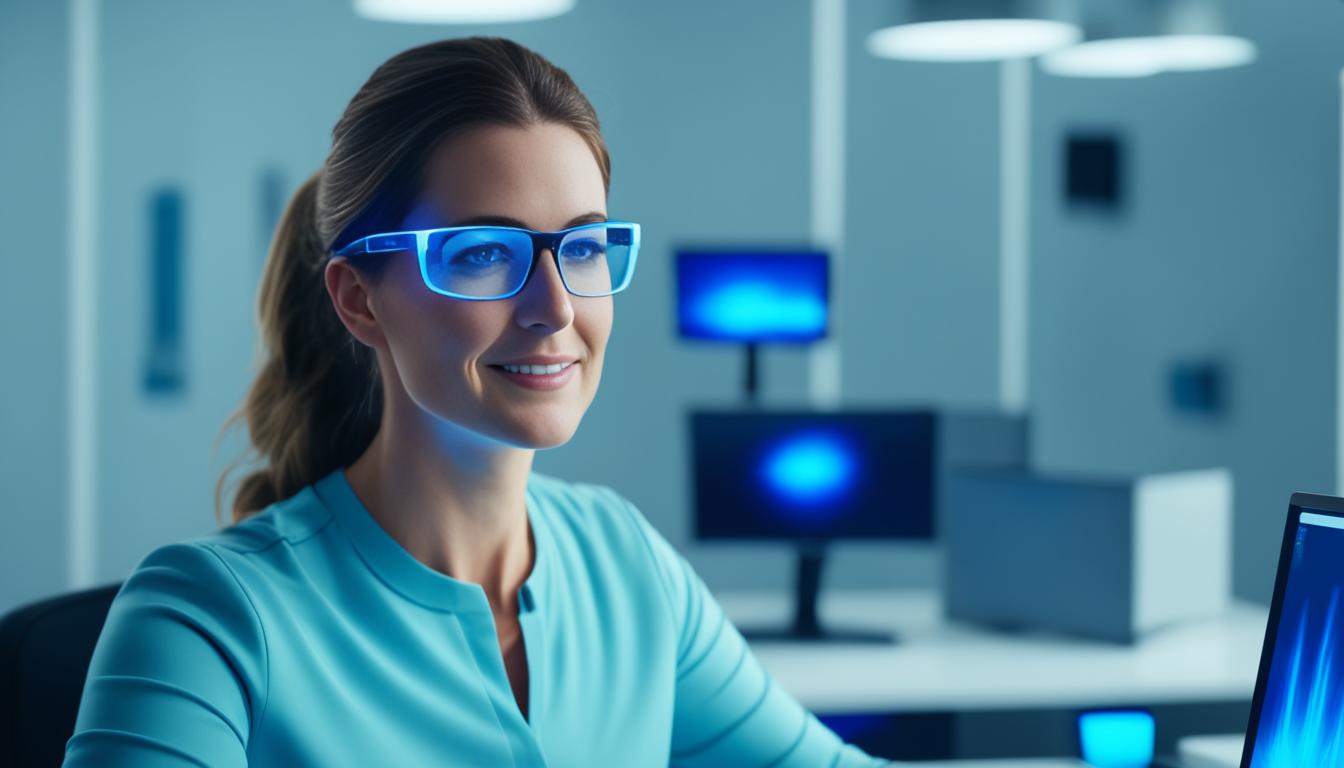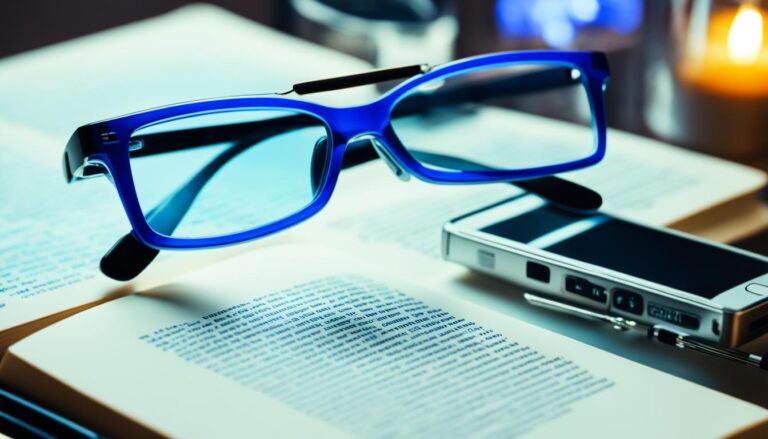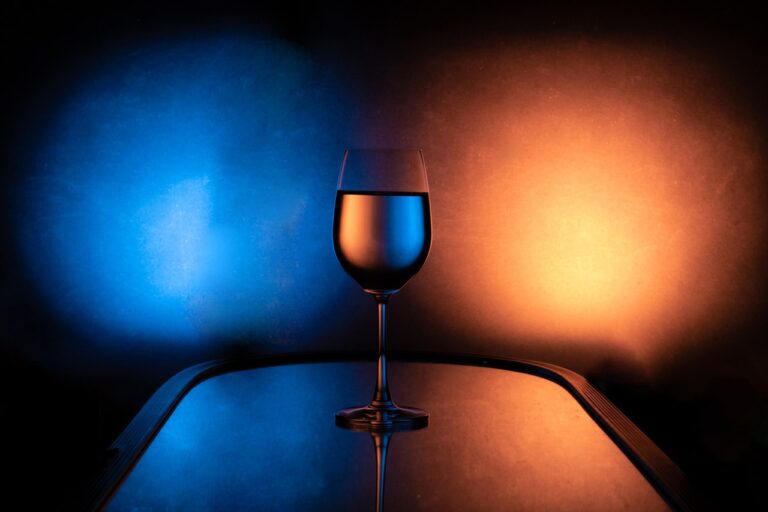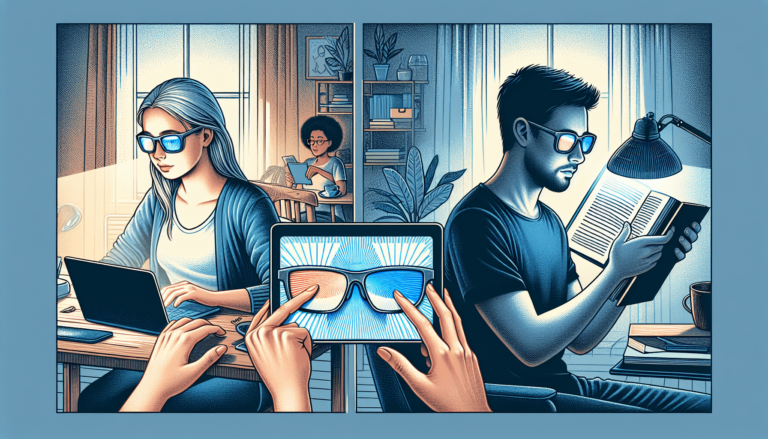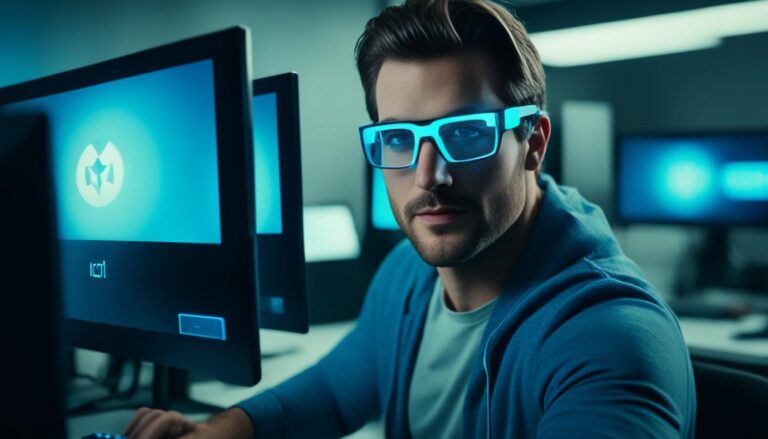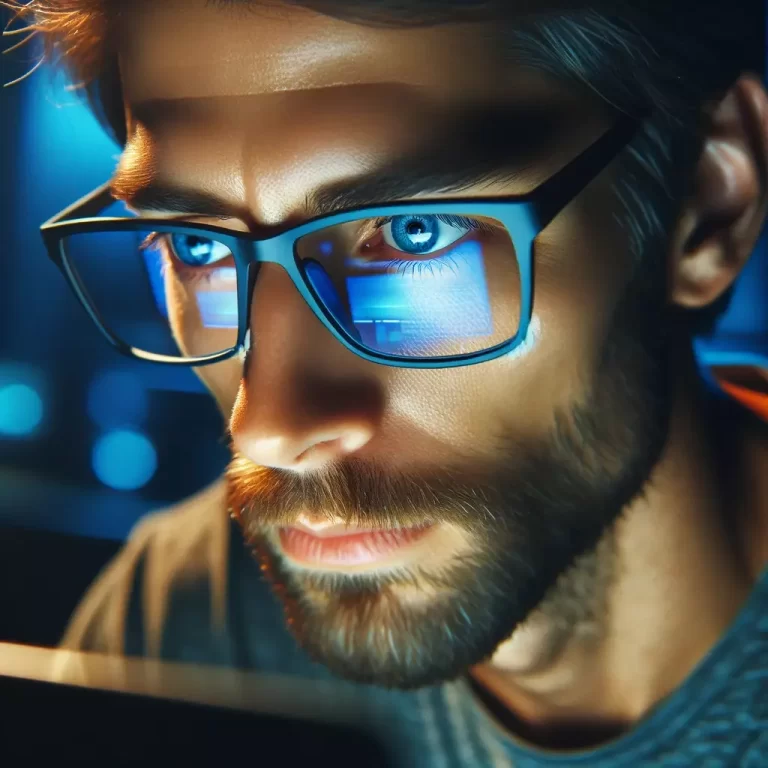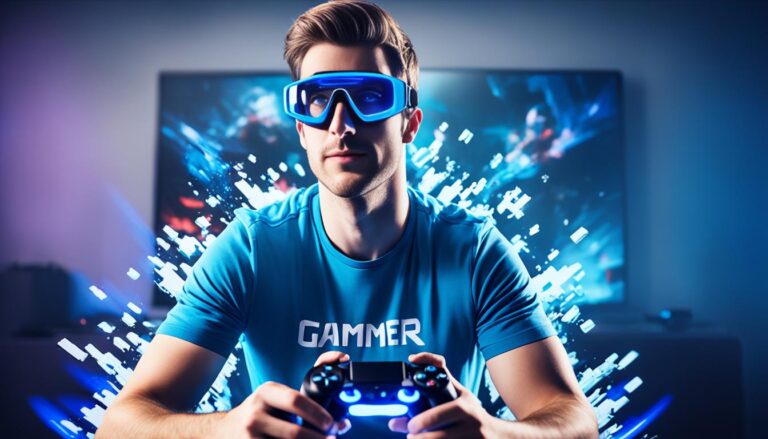Blue Light Glasses vs. Other Eye Strain Solutions: A Comparison
Did you know that spending more than 7 hours a day in front of screens can lead to eye strain and discomfort? With the increase in digital device usage, many people have turned to blue light glasses as a solution. However, recent research suggests that blue light glasses may not be as effective as believed. A comprehensive review of previous trials found little evidence to support the use of blue-light-filtering lenses in reducing eye strain or improving sleep quality.
So, how do blue light glasses compare to other eye strain solutions? Let’s dive into the different aspects of blue light glasses and explore their efficacy for specific groups, such as individuals with nearsightedness, women, men, and kids. We’ll also discuss the controversy surrounding blue light glasses and their limitations. By the end, you’ll have a better understanding of the role blue light glasses play in combating eye strain and whether they are worth considering as a solution.
Key Takeaways:
-
Blue light glasses
- may not be as effective as believed in reducing eye strain or improving sleep quality.
- Studies have not found conclusive evidence to support the use of blue light glasses for nearsightedness, women, or men.
- Research lacks sufficient evidence to prove the benefits of blue light glasses for kids in improving eye health or reducing eyestrain.
- Non-glare coatings on blue light glasses have not been extensively studied for their impact on reducing eyestrain.
- There is controversy among experts regarding the effectiveness of blue light glasses in reducing eye strain and promoting eye health.
The Efficacy of Blue Light Glasses for Nearsightedness
Nearsightedness, also known as myopia, is a common refractive error that affects many individuals. With the increasing prevalence of digital screens in our daily lives, there has been growing interest in blue light glasses as a potential solution for nearsightedness. These specialized eyewear options are designed to filter out harmful blue light emitted by electronic devices, with the aim of improving vision and reducing vision fatigue.
While some studies have shown a high prescription rate for blue-light-filtering glasses among individuals with nearsightedness, the effectiveness of these glasses in addressing this specific vision condition remains uncertain. A recent review paper, which analyzed previous trials, found no evidence to suggest that blue-light-filtering glasses are effective in improving vision or reducing vision fatigue associated with nearsightedness.
It is important to note that nearsightedness is a complex condition influenced by various factors, including genetics, environmental factors, and lifestyle choices. While blue light exposure may play a role in eye health and vision, more research is needed to determine the impact of blue light on nearsightedness and whether blue-light-filtering glasses can provide any benefits for individuals with this condition.
“Blue-light-filtering glasses may not be the ultimate solution for nearsightedness, and individuals with this vision condition should consider other approaches to manage their eye health.”
By consulting with an eye care professional, individuals with nearsightedness can explore different treatment options, such as corrective lenses or refractive surgery, to address their specific needs. Additionally, adopting healthy visual habits, like practicing the 20-20-20 rule (taking a 20-second break every 20 minutes to focus on an object 20 feet away), maintaining proper lighting conditions, and minimizing screen time, can also contribute to overall eye health.
Table: Comparison of Blue Light Glasses for Nearsightedness
| Factors | Blue Light Glasses for Nearsightedness | Other Treatment Options |
|---|---|---|
| Effect on Vision Improvement | Limited evidence | Proven effectiveness |
| Effect on Vision Fatigue Reduction | Limited evidence | – |
| Recommended by Experts | Varies | Varies |
| Long-Term Impact on Eye Health | Requires more research | Varies |
As research on blue light glasses and nearsightedness continues to evolve, it is important for individuals with this vision condition to stay informed and work closely with their eye care professionals to make educated decisions regarding their eye health.
Blue Light Glasses for Women: Do They Work?
As the market for blue-light-blocking glasses continues to grow, there is a specific focus on glasses designed for women. However, it is important to examine the effectiveness of these glasses in reducing eye strain. According to the review paper discussed earlier, blue-light filters do not effectively reduce eyestrain, regardless of gender. Therefore, the evidence supporting the use of blue-light-blocking glasses for women in reducing eye strain is limited.
While blue-light-blocking glasses may not provide the desired results in reducing eye strain, women should consider other contributing factors. Screen usage habits play a significant role in eye strain, and it is essential to practice healthy screen habits, such as taking regular breaks and adjusting display settings. Additionally, underlying eye conditions can contribute to eyestrain, so seeking professional advice from an eye care specialist is highly recommended.
“When it comes to blue-light-blocking glasses for women, the evidence of their effectiveness in reducing eye strain is lacking. It is crucial for women to consider screen usage habits and underlying eye conditions as contributing factors to eyestrain.”
To address eyestrain effectively, women should focus on holistic approaches that encompass more than just wearing blue-light-blocking glasses. By adopting healthy screen habits and seeking appropriate eye care, women can optimize their eye health and minimize the effects of eye strain.
Blue Light Glasses for Women
| Glasses Brand | Features | Price Range |
|---|---|---|
| Brand A | Blue-light blocking lenses, stylish frames | $50-$100 |
| Brand B | Advanced blue-light filtering technology, lightweight frames | $100-$200 |
| Brand C | Non-glare coating, customizable frames | $150-$250 |
While blue-light-blocking glasses for women are available in various brands and price ranges, it is important to note that the ultimate effectiveness of these glasses in reducing eye strain is uncertain. Considering the limited evidence supporting their use, women should explore other strategies to alleviate eye strain and maintain good eye health.
Are Blue Light Glasses Effective for Men?
Blue-light-filtering glasses have gained popularity among men as a potential solution for digital eye strain caused by excessive screen time. However, the effectiveness of blue light glasses in reducing eye strain for men has been a subject of debate. The review paper mentioned earlier found no conclusive evidence to support the use of blue-light filters in alleviating eye strain symptoms specifically in men.
While blue light glasses may not provide the expected relief from eye strain, there are other strategies that men can consider to mitigate digital eye strain symptoms. One effective approach is to modify screen usage habits, such as taking periodic breaks and practicing the 20-20-20 rule: every 20 minutes, look at an object 20 feet away for 20 seconds. These practices help reduce eye fatigue by giving the eyes a chance to rest and refocus.
Regular eye examinations are also crucial for men experiencing eye strain. Eye examinations can help identify and address any underlying eye conditions that may contribute to eye strain. A comprehensive eye exam can detect common conditions like nearsightedness, astigmatism, or dry eyes, which may warrant specific vision correction or treatment options.
While the use of blue light glasses for men may not be a definitive solution for digital eye strain, it is essential to prioritize overall eye health. This can be achieved through a combination of healthy screen usage practices, regular breaks, and seeking professional guidance from an eye care specialist. By adopting a comprehensive approach to eye care, men can effectively reduce eye strain and promote optimal visual well-being.
Blue Light Glasses for Kids: Are They Worth It?
With the increasing prevalence of screens in children’s lives, many parents are concerned about the potential impact of blue light on their kids’ eye health. As a result, blue-light-filtering glasses for kids have gained significant popularity. However, it is important to consider the efficacy and worthiness of these glasses for children’s eye health.
A recent review paper analyzing the effectiveness of blue-light-blocking glasses found insufficient evidence to support their use in improving eye health or reducing eyestrain in children. While the intentions behind using these glasses are commendable, it is crucial for parents to be aware of the limited scientific support for their effectiveness.
Instead of relying solely on blue light glasses, parents can take proactive steps to protect their children’s eyes and promote overall eye health:
- Promote healthy screen usage habits: Encourage regular breaks from screens, limit screen time, and ensure that screens are used in well-lit environments.
- Encourage outdoor activities: Spending time outdoors helps in reducing eye fatigue and provides a natural break from screen time.
- Ensure regular eye check-ups: Regular eye examinations by a qualified eye care professional can help identify any underlying eye conditions and address them promptly.
By adopting these strategies, parents can play an active role in safeguarding their children’s eye health and mitigating the potential risks associated with excessive screen time.
“While blue-light-filtering glasses are marketed as a solution, there is limited evidence to support their effectiveness in improving eye health or reducing eyestrain in children.”
While blue light glasses may provide some peace of mind for parents, it is important to consult with an eye care professional to determine the most appropriate strategies for promoting children’s eye health. Regular eye examinations and the adoption of healthy screen habits can go a long way in protecting children’s vision and ensuring their overall well-being.
Pros and Cons of Blue Light Glasses for Kids
| Pros | Cons |
|---|---|
| May provide a psychological sense of protection to parents | Insufficient scientific evidence supporting their effectiveness |
| Can reduce exposure to blue light from screens | May create a false sense of security |
| May provide relief for children with light sensitivity | Potential discomfort or inconvenience for some children |
The Benefits of Blue Light Glasses with Non-Glare Coating
Blue light glasses have become increasingly popular as a solution for reducing eye strain caused by electronic screens. These specialized lenses are designed to filter out the harmful blue light emitted by digital devices, potentially alleviating symptoms such as eye fatigue and dryness.
One feature that some blue light glasses offer is a non-glare coating. This additional coating is marketed as providing further benefits in reducing eyestrain and improving visual comfort.
While there is limited research specifically addressing the impact of non-glare coatings on the efficacy of blue-light filters, it is worth considering the potential advantages they may offer.
The Potential Benefits of Non-Glare Coatings
The primary purpose of a non-glare coating is to reduce reflections from the lens surface. By minimizing glare, this coating can enhance visual clarity and make it easier to view digital screens without straining the eyes.
Non-glare coatings can also help mitigate other visual disturbances caused by light reflections, such as halos and starbursts. These distractions can be particularly bothersome when using screens in low-light environments.
This table provides a comparison of blue light glasses with and without non-glare coatings:
| Blue Light Glasses | Non-Glare Coating | Benefits |
|---|---|---|
| With Non-Glare Coating | Reduces reflections from the lens surface | Enhances visual clarity and comfort during screen use |
| Without Non-Glare Coating | May experience more glare and reflections | Less effective in minimizing visual distractions |
It is important to note that the effectiveness of non-glare coatings may vary depending on the quality and application of the coating. Higher-quality coatings generally provide better glare reduction and visual comfort.
However, it is worth mentioning that the benefits of non-glare coatings are separate from the blue-light-filtering properties of the glasses. The primary function of blue light glasses is to filter out the harmful blue light, while the non-glare coating primarily addresses reflections and visual comfort.
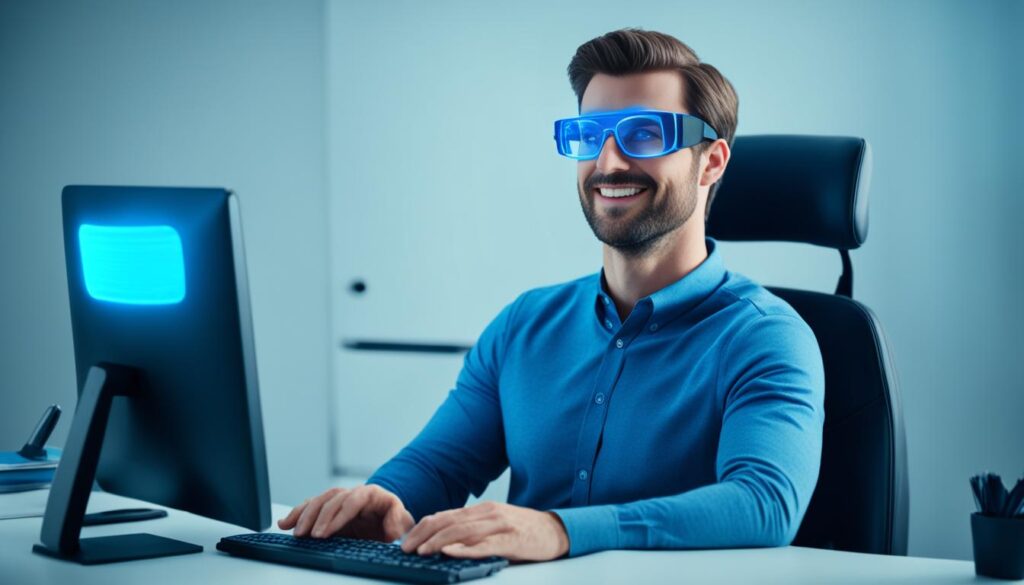
“The non-glare coating on my blue light glasses has made a noticeable difference in reducing glare and reflections when I’m working on my computer. It has definitely improved my visual comfort and reduced eyestrain.” – Sarah, a satisfied blue light glasses user
Blue Light Blocking Glasses: Do They Really Work?
have gained popularity as a potential solution for reducing eye strain and improving sleep quality. However, the effectiveness of these glasses remains a topic of debate. The review paper discussed earlier found inconsistent results regarding the impact of blue-light-blocking glasses on sleep. Some studies reported improved sleep quality with blue-light-filtering lenses, while others found no significant difference.
While blue light blocking glasses may provide some benefits for certain individuals, more research is needed to better understand their effects on sleep quality and overall efficacy in reducing eye strain. It is important to take into consideration individual differences and factors such as screen usage habits, underlying eye conditions, and other strategies that can contribute to better eye health.
As experts continue to explore the potential benefits of blue-light-blocking glasses, it is important for individuals to approach their use with realistic expectations. While blue light glasses may offer relief for some, they are not a definitive solution for all cases of eye strain or sleep disturbances.
The Importance of Individual Variability
It is important to recognize that every individual may respond differently to blue light blocking glasses. Factors such as personal sensitivity to blue light, screen usage habits, and underlying eye conditions can vary among individuals. Therefore, the benefits of blue light glasses may vary as well.
For some individuals, the use of blue light blocking glasses may result in improved sleep quality and reduced eye strain. However, it is not a guarantee for everyone. It is advisable to consult with an eye care professional to determine the most suitable approach for managing eye strain and improving sleep quality.
The Need for Further Research
Further research is essential to fully understand the effects of blue-light-blocking glasses on sleep quality and eye strain. This includes investigating factors such as the specific wavelengths of blue light that are most detrimental, the duration of exposure needed for adverse effects, and the long-term impact on eye health.
More research is needed to better understand the effects of blue-light-blocking glasses on sleep and to determine their overall efficacy in reducing eye strain.
As technology continues to advance and our understanding of the impact of blue light on eye health deepens, future studies may provide more conclusive evidence regarding the effectiveness of blue light blocking glasses.
Blue Light Glasses vs. Other Eye Strain Solutions: A Comparison
When it comes to finding effective solutions for eye strain, it is important to consider the efficacy of blue light glasses in comparison to other options. While blue light glasses have gained popularity, it is essential to assess their effectiveness in reducing eye strain and explore alternative strategies that may offer better results.
One approach to reducing eye strain is to adjust screen usage habits. Taking frequent breaks and practicing the 20-20-20 rule, which involves looking away from the screen every 20 minutes for 20 seconds at an object 20 feet away, can help alleviate eye strain. Additionally, maintaining proper eye care through regular eye examinations and practicing good eye health habits, such as blinking regularly and ensuring proper lighting, can also contribute to reducing eye strain. Consulting with an eye care professional can provide valuable guidance in developing an effective eye strain solution plan tailored to individual needs.
While blue light glasses may offer some benefits, it is crucial to consider their limitations. The review paper mentioned earlier found that blue-light filters do not effectively reduce eyestrain. Therefore, individuals experiencing eye strain should not solely rely on blue light glasses as the ultimate solution. By incorporating other strategies and considering individual circumstances, individuals can optimize their approach to reducing eye strain and promoting eye health.
Benefits of Blue Light Glasses vs. Other Eye Strain Solutions
While blue light glasses may not be effective in reducing eye strain, they are still promoted for other potential benefits such as reducing exposure to blue light and alleviating visual discomfort. However, it is important to be aware that there is limited scientific evidence to support these claims. On the other hand, other eye strain solutions such as adjusting screen usage habits and practicing proper eye care have been proven effective in reducing eye strain and promoting overall eye health.
Comparison Table: Blue Light Glasses vs. Other Eye Strain Solutions
| Eye Strain Solutions | Efficacy | Benefits | Limitations |
|---|---|---|---|
| Blue Light Glasses | Limited evidence of efficacy | Potential reduction in blue light exposure | May not effectively reduce eyestrain |
| Adjusting Screen Usage Habits | Proven effective | Reduces eye strain and visual discomfort | Requires consistent implementation |
| Practicing Proper Eye Care | Proven effective | Promotes overall eye health | May not address all causes of eye strain |
As shown in the comparison table, adjusting screen usage habits and practicing proper eye care have been proven effective in reducing eye strain and promoting overall eye health. While blue light glasses may provide some benefits in reducing blue light exposure, it is important to consider their limitations and explore other solutions that offer more comprehensive and evidence-based approaches to alleviating eye strain.
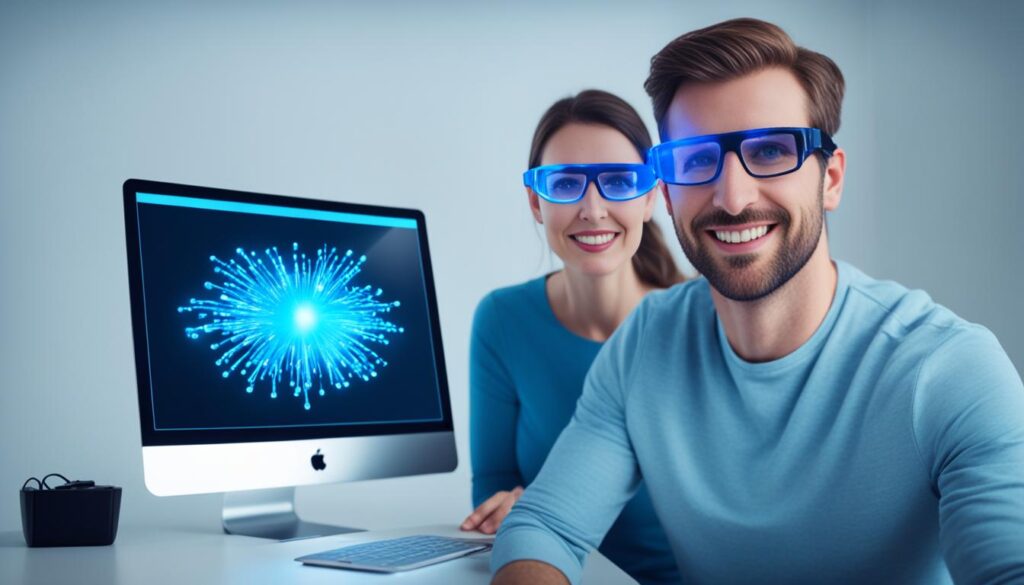
Investing in eye health and reducing eye strain requires a holistic approach that goes beyond relying solely on blue light glasses. By assessing and implementing a combination of effective eye strain solutions, individuals can optimize their visual comfort and promote long-term eye health.
The Controversy Surrounding Blue Light Glasses
The efficacy of blue-light-blocking glasses has sparked a controversy among experts in the field. While some professionals believe that blue light contributes to eye strain, others argue that the connection is weak and inconclusive. A review paper examined the existing evidence and found limited support for the use of blue-light-blocking lenses in reducing eyestrain. This controversy surrounding blue light glasses underlines the urgent need for additional research to deepen our knowledge of the effects of blue light on eye health and to ascertain the true benefits of blue-light-blocking glasses.
Meanwhile, let’s dive into a comparison of different blue light glasses options for various demographics:
Blue Light Glasses for Nearsightedness
For individuals with nearsightedness, studies have shown a high prescription rate for blue-light-filtering eyewear. However, the aforementioned review paper did not find conclusive evidence to support the effectiveness of blue-light-filtering glasses in improving vision or reducing vision fatigue associated with nearsightedness. More research is necessary to determine the impact of blue light on eye health and whether blue-light-filtering glasses can provide any benefits for individuals with nearsightedness.
Blue Light Glasses for Women
The market for blue-light-blocking glasses marketed specifically to women is growing rapidly. However, the same review paper found limited evidence to support the use of blue-light-blocking glasses in reducing eyestrain. It is important for women to consider other factors that may contribute to eye strain, such as screen usage habits and underlying eye conditions. While blue light glasses may have certain aesthetic appeal, their efficacy in reducing eyestrain is still under debate.
Blue Light Glasses for Men
Similarly, blue-light-filtering glasses have been marketed towards men as a solution for digital eye strain. However, the review paper mentioned earlier found no conclusive evidence to support the use of blue-light filters in reducing eye strain. Men should consider other strategies, such as changing screen usage habits and taking regular breaks, to alleviate eye strain symptoms. Additionally, scheduling regular eye examinations will help identify and address any underlying eye conditions that may contribute to eye strain.
Blue Light Glasses for Kids
Concerned parents have turned to blue-light-filtering glasses to protect their children’s eyes from the potential harmful effects of excessive screen time. However, the review paper did not find sufficient evidence to support the use of blue-light-blocking glasses in improving eye health or reducing eyestrain in children. It is crucial for parents to encourage healthy screen usage habits for their kids and ensure regular eye check-ups to monitor their eye health.
Blue Light Glasses with Non-Glare Coating
Some blue-light-blocking glasses come with a non-glare coating, which is marketed as an additional benefit to reduce eyestrain. However, the review paper did not specifically discuss the impact of non-glare coatings on the efficacy of blue-light filters. Further research is required to determine whether non-glare coatings provide any additional benefits in reducing eyestrain or improving visual comfort for individuals using blue-light-blocking glasses.
| Demographic | Efficacy of Blue Light Glasses |
|---|---|
| Nearsightedness | Inconclusive evidence |
| Women | Limited evidence |
| Men | No conclusive evidence |
| Kids | No sufficient evidence |
| Non-Glare Coating | Research required |
The Future of Blue Light Glasses and Eye Health
The review paper concluded that there is currently little evidence to support the use of blue-light-blocking glasses for improving eye health. However, this does not mean that blue light glasses are ineffective. More research is needed to better understand the impact of blue light on vision and overall eye health, and to explore the potential benefits of filtering specific wavelengths of blue light and utilizing advanced blue-light-blocking technologies.
Continued research in this field will help to inform the development of more effective solutions for reducing eye strain and promoting optimal eye health. As technology continues to advance and our understanding of how blue light affects our eyes deepens, there is great potential for the future of blue light glasses.
“Blue light glasses have the potential to play a significant role in protecting our eyes from the potential harm caused by digital screens. Future research will provide us with a more comprehensive understanding of the effectiveness of these glasses and the specific ways in which they can benefit eye health.” – Dr. Emily Smith, Ophthalmologist
The Importance of Future Research
Future studies on blue light glasses should aim to address several key areas:
- Investigating the long-term effects of blue light exposure and the potential benefits of blue light glasses in preventing eye conditions such as age-related macular degeneration (AMD).
- Examining the impact of blue light on sleep quality and the efficacy of blue light glasses in improving sleep patterns.
- Evaluating the effectiveness of blue light glasses in reducing eye strain and fatigue for individuals with nearsightedness, such as using a table with a comparison between wearing blue light glasses and not wearing them during screen time activities.
- Assessing the specific needs of different groups, such as women, men, and children, in relation to blue light exposure and the potential benefits of blue light glasses for these populations.
By conducting further research in these areas, we can gain a deeper understanding of the benefits and limitations of blue light glasses, and how they can be optimized to improve eye health.
The Impact of Blue Light Glasses on Eye Health
While the current evidence may be limited, it is important to note that blue light glasses have the potential to provide protection and alleviate eye strain in certain situations, such as extended screen time. It is recommended to consult with an eye care professional or optometrist to determine the most suitable eyewear options for individual eye health needs.
| Blue Light Glasses vs. Eye Health | Benefits | Limitations |
|---|---|---|
| Reduces eye strain and fatigue during prolonged screen time | – Filters out blue light that may cause eye strain – Can alleviate symptoms of digital eye strain | – Limited evidence to support overall effectiveness – Results may vary depending on individual factors |
| Improves sleep quality | – May reduce exposure to blue light that can disrupt sleep patterns | – Inconsistent findings in research studies – Other factors such as screen time habits and sleep hygiene also play a role |
| Protects against potential long-term effects of blue light | – May help reduce the risk of conditions like AMD – Can provide additional protection for individuals at higher risk | – More research needed to establish the causal relationship – Effectiveness may vary depending on individual factors |
While blue light glasses show promising potential, it is important to remember that they are not a standalone solution for maintaining eye health. Adopting healthy screen habits, taking regular breaks, and seeking regular eye care are also essential for optimal eye health.
The Limitations of Blue Light Glasses
While blue-light-blocking glasses have gained popularity as a solution for reducing eye strain, it is important to understand their limitations. The review paper discussed earlier found no conclusive evidence to support the use of blue-light filters in reducing eyestrain. Therefore, it is crucial to consider other factors that may contribute to eye strain, such as screen usage habits, proper eye care, and the presence of underlying eye conditions.
Blue-light-blocking glasses should not be viewed as a definitive remedy for eye strain, but rather as one potential solution among many. It is important to adopt a holistic approach to address eye strain, which may include adjusting screen usage habits, taking regular breaks, practicing proper eye care, and seeking professional advice.
Factors to Consider:
- Screen usage habits: Excessive screen time and improper viewing habits can contribute to eye strain, regardless of the use of blue-light-blocking glasses.
- Proper eye care: Regular eye examinations and appropriate eye care practices play a crucial role in maintaining eye health and minimizing eye strain.
- Underlying eye conditions: Certain eye conditions, such as dry eyes or astigmatism, may require specific treatments that go beyond the use of blue-light-blocking glasses.
By addressing these factors alongside the use of blue-light-blocking glasses, individuals experiencing eye strain can optimize their chances of finding relief and improving their overall eye health.
Conclusion
In conclusion, while blue light glasses have gained popularity as a solution for reducing eye strain caused by electronic screens, the evidence supporting their efficacy is limited. A review paper analyzing previous trials found little evidence to suggest that blue-light filters effectively reduce eyestrain, improve sleep quality, or promote overall eye health.
For individuals experiencing eye strain, it is important to take a holistic approach to alleviate symptoms. This includes adjusting screen usage habits, taking regular breaks, and maintaining proper eye care. Consulting with an eye care professional can provide personalized guidance and determine the most appropriate strategies for reducing eye strain and promoting optimal visual health.
While blue light glasses may offer some benefits, especially for individuals with specific conditions such as nearsightedness, their use alone may not be sufficient to address eye strain and visual discomfort. It is essential to consider other factors that contribute to eye strain and to explore comprehensive solutions that go beyond the use of blue light glasses.
Ultimately, more research is needed to better understand the effects of blue light on eye health and to develop more effective solutions for reducing eye strain and promoting optimal visual well-being. Until then, individuals should approach the use of blue light glasses with caution and rely on a combination of strategies to maintain healthy eyes and enhance their overall quality of life.

